Daves Old Computers - PC compatibles
When IBM introduced the PC in 1981, the computing world changed. In a remarkably short
time, the industry focus shifted from the many different and rarely compatible architectures
existing before the PC to a standard platform with which which even todays machines maintain
some level of compatibility.
The standardization of the PC architecture, coupled with the wildly increasing popularity
of personal computers in the past two decades has made them plentiful. Adding to that the
fact that modern computers become obsolete almost before you get them home, we can see why
there are thousands upon thousands of older, unused PC compatible machines tucked away in
closets and basements of every city, town and village in the country.
There is simply no way I could collect and store any significant percentage of the PC
compatible machines which have been produced. For this reason, I am limiting my collection
of PC compatibles to
- Very early machines
- Name brand machines (IBM, DEC, Compaq etc.)
- Rare/Oddball machines
I do have more generic laptops in the collection that you would expect, that is because
many of these machines I purchased new, and kept them because in my work as an embedded
systems designer, I often need multiple "terminals" to connect to the various debug ports
of the systems I am working on.
Click any photo to view a large high-resolution image.
Desktops
 Where it all started. This is the original first edition 5150 PC, with
64K/256K mainboard. This is the only mainline IBM PC computer with a cassette
interface (The PCjr also has a tape interface), which can be seen in a
view from the back . Here is the
original documentation.
5150 PC Donated by Bob Maxwell.
Where it all started. This is the original first edition 5150 PC, with
64K/256K mainboard. This is the only mainline IBM PC computer with a cassette
interface (The PCjr also has a tape interface), which can be seen in a
view from the back . Here is the
original documentation.
5150 PC Donated by Bob Maxwell.
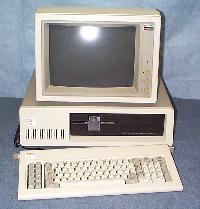 The 5160 XT was the second generation of IBM personal computer. Physically
almost identical to the original PC, this machine featured more RAM, and
ROM upgrades including the ability to support a hard disk. Here is a
PC/XT advertisement from 1983. Here is the
technical reference manual.
5160 XT Donated by Bill VanDijk.
The 5160 XT was the second generation of IBM personal computer. Physically
almost identical to the original PC, this machine featured more RAM, and
ROM upgrades including the ability to support a hard disk. Here is a
PC/XT advertisement from 1983. Here is the
technical reference manual.
5160 XT Donated by Bill VanDijk.
 The 4860 PCjr was IBM's attempt to enter the home market. Withdrawn after
only two years, the machine did not fare well, mainly due to incompatibilities
with the mainline PC models. The model shown is a 4860-067, which came with
128K ram and a floppy disk drive. Two "sidecar" expansion modules have been
added, bringing the RAM to 640k, and adding a printer port.
The 4860 PCjr was IBM's attempt to enter the home market. Withdrawn after
only two years, the machine did not fare well, mainly due to incompatibilities
with the mainline PC models. The model shown is a 4860-067, which came with
128K ram and a floppy disk drive. Two "sidecar" expansion modules have been
added, bringing the RAM to 640k, and adding a printer port.
 This Hewlet Packard 150II is best described as a "PC incompatible".
Although it uses the 8088 processor, its other hardware is different enough that
it will only run HPs own version of DOS. The main computer resides in the
Monitor - the box on top is a floppy/hard drive unit. Views:
Back, Connections.
This Hewlet Packard 150II is best described as a "PC incompatible".
Although it uses the 8088 processor, its other hardware is different enough that
it will only run HPs own version of DOS. The main computer resides in the
Monitor - the box on top is a floppy/hard drive unit. Views:
Back, Connections.
 The 5170 AT is essentially a bigger faster PC - It's Intel 80286 processor could
supported virtual memory, but most software could not. The AT was the first PC
to support high-capacity (1.2M) floppy drives, and store it's setup parameters
in CMOS memory.
The 5170 AT is essentially a bigger faster PC - It's Intel 80286 processor could
supported virtual memory, but most software could not. The AT was the first PC
to support high-capacity (1.2M) floppy drives, and store it's setup parameters
in CMOS memory.
Views:
Back,
Inside.
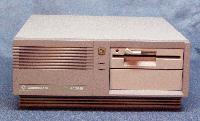 In contrast to their wildly successful C64, which sold more unit than any
other machine, Commodore only made a few PC's. This is a PC20-III, an XT
clone with 20mb hard drive.
In contrast to their wildly successful C64, which sold more unit than any
other machine, Commodore only made a few PC's. This is a PC20-III, an XT
clone with 20mb hard drive.
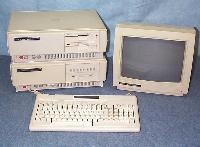 The Tandy 1000 series was a very early line of IBM compatibles which didn't try
"too hard" to be fully IBM compatible. The 1000SX on the top is an 8088 based
machine which is more like a PCjr than a PC/XT. The 1000TX model on the bottom
is a 80286 based machine, however it lies somewhere between IBM's 8088 XT and
the 80286 AT because it has only 8-bit XT style expansion slots. The Tandys used
a non-standard keyboard with an 8-pin DIN connector (instead of 5). Even the diskette
drives were different, receiving their power through the data cable, not a separate
power cable. Here is a Tandy 100 SX AD from 1987
Tandy Computer Catalog.
The Tandy 1000 series was a very early line of IBM compatibles which didn't try
"too hard" to be fully IBM compatible. The 1000SX on the top is an 8088 based
machine which is more like a PCjr than a PC/XT. The 1000TX model on the bottom
is a 80286 based machine, however it lies somewhere between IBM's 8088 XT and
the 80286 AT because it has only 8-bit XT style expansion slots. The Tandys used
a non-standard keyboard with an 8-pin DIN connector (instead of 5). Even the diskette
drives were different, receiving their power through the data cable, not a separate
power cable. Here is a Tandy 100 SX AD from 1987
Tandy Computer Catalog.
 This pair of Philips PC's represents higher-end more industrial PC compatibles. The P3355
on the bottom features a separate CPU card which was supposed to provide upgrade capility.
In practice, this almost never happened, because the rest of the machine would also be
obsolete by the time a new CPU was desired. Both of these machines have 80386SX CPUs.
This pair of Philips PC's represents higher-end more industrial PC compatibles. The P3355
on the bottom features a separate CPU card which was supposed to provide upgrade capility.
In practice, this almost never happened, because the rest of the machine would also be
obsolete by the time a new CPU was desired. Both of these machines have 80386SX CPUs.
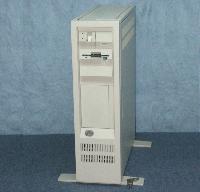 This is the IBM PS/2 Model 80 - The top model of the early PS/2 releases. The
PS/2 is a redesign of the original IBM PC, which retained backward compatibility
while improving performance with a high speed "microchannel" bus.
This is the IBM PS/2 Model 80 - The top model of the early PS/2 releases. The
PS/2 is a redesign of the original IBM PC, which retained backward compatibility
while improving performance with a high speed "microchannel" bus.
 Top: This IBM PS/2 Model 70 is an early desktop entry in the PS/2 line. This
machine is one of the few that has an IBM manufactured (under license from
Intel) 80386 CPU. Donated by Stephan Suys.
Top: This IBM PS/2 Model 70 is an early desktop entry in the PS/2 line. This
machine is one of the few that has an IBM manufactured (under license from
Intel) 80386 CPU. Donated by Stephan Suys.
Bottom: The IBM PS/2 Model 55sx is a cost reduced machine which utilizes the
80386SX processor (16 bit bus instead of 32). This is the first microchannel
based PS/2 which has the cards inserted horizontally, allowing a lower profile
case.
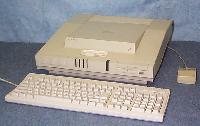 This Apricot 80386 PC is another rather oddball design which does not resemble any
other PC that I have seen.
This Apricot 80386 PC is another rather oddball design which does not resemble any
other PC that I have seen.
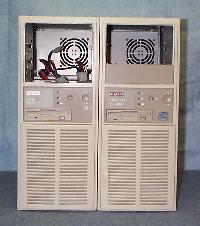 Digital Equipment Corp., makers of the famous PDP series of minicomputers also got into
the PC business. Here is a "Dec PC" and a "Prioris" which are obviously the same chassis
and 486 mainboard.
Digital Equipment Corp., makers of the famous PDP series of minicomputers also got into
the PC business. Here is a "Dec PC" and a "Prioris" which are obviously the same chassis
and 486 mainboard.
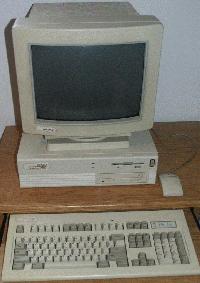 This Compaq Prolinia 4/25 has been upgraded with the Intel 486 DX4/100 overdrive
processor. It is still being used by my Mom as an internet email machine.
This Compaq Prolinia 4/25 has been upgraded with the Intel 486 DX4/100 overdrive
processor. It is still being used by my Mom as an internet email machine.
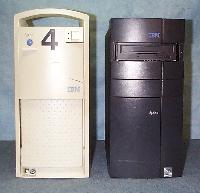 A pair of more recent IBM machines. These Aptivas represent typical IBM personal
computer models in the mid 1990's. The one on the right is the premium black
"Stealth" model.
A pair of more recent IBM machines. These Aptivas represent typical IBM personal
computer models in the mid 1990's. The one on the right is the premium black
"Stealth" model.
Portables and Laptops
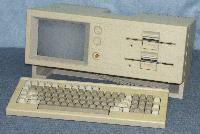 The Bytec/Dynalogic Hyperion is the very first portable PC - beating Compaq
to market by about 3 months. This was a leading edge machine in it's day:
It was very compact, weighed less than 20 pounds, and packed into a nice
carrying case. The machine did poorly due
to chronic floppy drive problems, and the fact that it was not 100% hardware
compatible with the PC (at this early stage in PC development, designers
believe that software would be "well behaved" and access the hardware only
through the BIOS interface.)
The Bytec/Dynalogic Hyperion is the very first portable PC - beating Compaq
to market by about 3 months. This was a leading edge machine in it's day:
It was very compact, weighed less than 20 pounds, and packed into a nice
carrying case. The machine did poorly due
to chronic floppy drive problems, and the fact that it was not 100% hardware
compatible with the PC (at this early stage in PC development, designers
believe that software would be "well behaved" and access the hardware only
through the BIOS interface.)
View from the back (unit on top has an
external memory expansion box attached).
Hyperion Documentation.
Maintenance Manual (12.5M PDF)
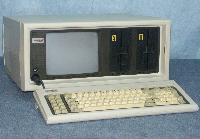 The Compaq Portable PC is the first successful portable PC. It had a very high
degree of PC compatibility, running virtually all of the software that ran on
the PC. It also has the capability to accept full size PC expansion cards. With
the cover removed, we see a well shielded chassis.
Inside we can see the diskette drives, video monitor,
power supply and expansion slots. Here it is Closed,
and also view of the side access panels.
The Compaq Portable PC is the first successful portable PC. It had a very high
degree of PC compatibility, running virtually all of the software that ran on
the PC. It also has the capability to accept full size PC expansion cards. With
the cover removed, we see a well shielded chassis.
Inside we can see the diskette drives, video monitor,
power supply and expansion slots. Here it is Closed,
and also view of the side access panels.
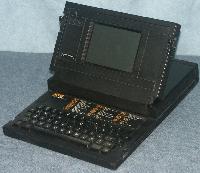 Grid Compass 1101 - slightly updated edition of the 1100, reportedly the first
PC laptop with a folding screen. The Compass was very high-end in it's day, built
into a compact magnesium alloy casing, it features a true 16-bit 8086 (Faster
than the PCs 8088), a gas-plasma screen, and bubble memory
for mass storage. Views: Closed (with optional
floppy drive/expansion box), Back. Donated by Richard Parsons.
Grid Compass 1101 - slightly updated edition of the 1100, reportedly the first
PC laptop with a folding screen. The Compass was very high-end in it's day, built
into a compact magnesium alloy casing, it features a true 16-bit 8086 (Faster
than the PCs 8088), a gas-plasma screen, and bubble memory
for mass storage. Views: Closed (with optional
floppy drive/expansion box), Back. Donated by Richard Parsons.
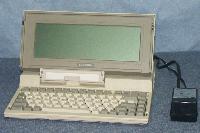 The Toshiba T1000 is the first battery powered/LCD portable labtop format PC.
It features a 4.77 Mhz 8088 CPU, 512K of RAM, DOS in ROM, and a 720k diskette
drive.
The Toshiba T1000 is the first battery powered/LCD portable labtop format PC.
It features a 4.77 Mhz 8088 CPU, 512K of RAM, DOS in ROM, and a 720k diskette
drive.
Donated by Rich Lafferty.
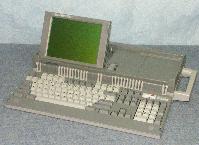 The Amstrad PPC640 is an interesting design, the keyboard folds over flat,
then the screen pops up. Dual floppy drives are at the end with the carry
handle. This machine runs on the AC adapter, a 12v DC "car cord", or 10 'C'
cell batteries!
The Amstrad PPC640 is an interesting design, the keyboard folds over flat,
then the screen pops up. Dual floppy drives are at the end with the carry
handle. This machine runs on the AC adapter, a 12v DC "car cord", or 10 'C'
cell batteries!
View closed with accessories.
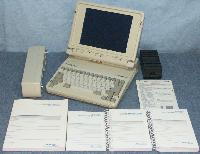 This Zenith SuperSport 8088 laptop is one of the most popular of the early
LCD laptop format machines. It features 640k of RAM, and dual 720k floppy
drives. The large box on the left is a battery pack which clips onto the back
of the machine.
This Zenith SuperSport 8088 laptop is one of the most popular of the early
LCD laptop format machines. It features 640k of RAM, and dual 720k floppy
drives. The large box on the left is a battery pack which clips onto the back
of the machine.
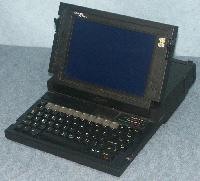 Grid GridCase 1535EXP - Basically the same cabinet as the original 1100/1101,
the 1535 is a later model Grid with 80386 processor and LCD display. Very rugged
and reliable, it was reportedly designed for NASA to be used in space.
Views: Closed (with optional battery pack),
Back. Donated by Bob Leblanc.
Grid GridCase 1535EXP - Basically the same cabinet as the original 1100/1101,
the 1535 is a later model Grid with 80386 processor and LCD display. Very rugged
and reliable, it was reportedly designed for NASA to be used in space.
Views: Closed (with optional battery pack),
Back. Donated by Bob Leblanc.
 The Atari Portfolio is the first palmtop PC.
The Atari Portfolio is the first palmtop PC.
Click the picture to go to my Portfolio page.
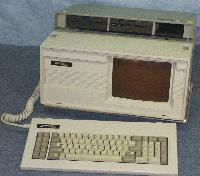 Believe it or not, the Zenith Z160 was considered a "portable" machine.
It was larger and heavier than most desktops, but it did include an internal
monitor and *could* be carried around. It's an odd design with the disk
drives popping up from a panel in the top of the machine. Internally, it
has a passive backplane, with the CPU, Memory and other traditional "mainboard"
resources located in removable cards. Donated by Mike Kenzie.
Believe it or not, the Zenith Z160 was considered a "portable" machine.
It was larger and heavier than most desktops, but it did include an internal
monitor and *could* be carried around. It's an odd design with the disk
drives popping up from a panel in the top of the machine. Internally, it
has a passive backplane, with the CPU, Memory and other traditional "mainboard"
resources located in removable cards. Donated by Mike Kenzie.
View closed.
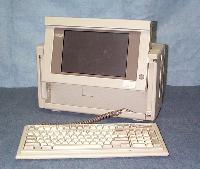 This Compaq 80286 "portable" features a gas-plasma screen which snaps up from underneath
a removable keyboard.
This Compaq 80286 "portable" features a gas-plasma screen which snaps up from underneath
a removable keyboard.
View closed.
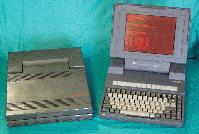 The T3100 series was among the first "laptop" format portable 286 computers.
The T3100/20 on the left is the original 8mhz model (20M HD version), while
the T3100e on the right is updated with a 12mhz CPU and HD floppy drive. These
machines had no battery (AC power only), however the AC supply was built in,
so no external power supply was required. The orange plasma display is CGA
compatible, with an extra 600x400 high resolution graphic mode.
The T3100 series was among the first "laptop" format portable 286 computers.
The T3100/20 on the left is the original 8mhz model (20M HD version), while
the T3100e on the right is updated with a 12mhz CPU and HD floppy drive. These
machines had no battery (AC power only), however the AC supply was built in,
so no external power supply was required. The orange plasma display is CGA
compatible, with an extra 600x400 high resolution graphic mode.
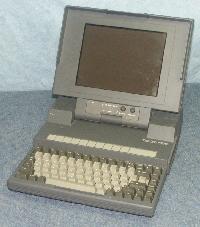 Another early Toshiba, the T5100 is very similar to the T3100 above, except
with a 80386 processor. This was one of the first laptops which could run
32 bit code, and was considered very powerful at the time. Donated by Rich
Lafferty.
Another early Toshiba, the T5100 is very similar to the T3100 above, except
with a 80386 processor. This was one of the first laptops which could run
32 bit code, and was considered very powerful at the time. Donated by Rich
Lafferty.
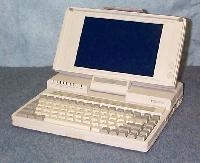 The Toshiba TX1200XE is a fairly standard 80286 laptop computer from the early 90's.
Donated by Doug Terry and Rich Lafferty.
The Toshiba TX1200XE is a fairly standard 80286 laptop computer from the early 90's.
Donated by Doug Terry and Rich Lafferty.
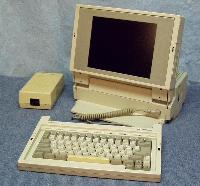 The Zenith TurboSport386 is an early large format 80386 portable. This machine features
a detachable keyboard. It also uses the biggest battery I have ever seen in a "portable".
At 26 pounds it's definately not a laptop. Here is is
closed up. Donated by G. Morrison.
The Zenith TurboSport386 is an early large format 80386 portable. This machine features
a detachable keyboard. It also uses the biggest battery I have ever seen in a "portable".
At 26 pounds it's definately not a laptop. Here is is
closed up. Donated by G. Morrison.
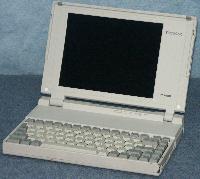 The T2200SX is another early 80386 based laptop from Toshiba.
The T2200SX is another early 80386 based laptop from Toshiba.
Donated by Bill Mckinnon.
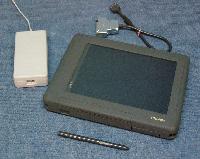 The Toshiba T200CS is an early Tablet/Pen computer. Looking like a big "palm", this
machine runs a special edition of Windows 3 called "Pen windows".
The Toshiba T200CS is an early Tablet/Pen computer. Looking like a big "palm", this
machine runs a special edition of Windows 3 called "Pen windows".
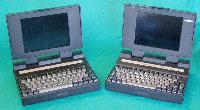 EuroCom Note3300 (left) and Note3300A (right), The 'A' version has two serial ports,
and no external floppy connector. These are 386DX based machines. EuroCom is a Canadian
company that specializes in notebook computers using desktop CPU's. I still use the
3300A as a DataScope, with a "Y" cable between the two serial ports.
EuroCom Note3300 (left) and Note3300A (right), The 'A' version has two serial ports,
and no external floppy connector. These are 386DX based machines. EuroCom is a Canadian
company that specializes in notebook computers using desktop CPU's. I still use the
3300A as a DataScope, with a "Y" cable between the two serial ports.
3300 accessories, Clockwise from top left:
Mini-Docking station (2 cards), Carry bag, external 2-pack charger, Battery (goes across
back of machine), Documentation. Middle: External keypad.
Note3300 donated by Gary Mussar.
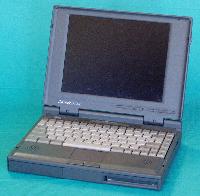 This Twinhead Slimnote 5100C was a top of the line machine in its day, with a fast 486/100
processor, color screen and 24MB of memory. I still use it from time to time as a portable
DOS machine.
This Twinhead Slimnote 5100C was a top of the line machine in its day, with a fast 486/100
processor, color screen and 24MB of memory. I still use it from time to time as a portable
DOS machine.
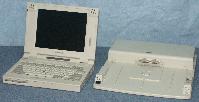 This is a Compaq LTE-5100, shown with it's optional docking station. This
machine contains a Pentium-90 processor with the famous Intel floating-point
bug. Donated by Bill Mckinnon.
This is a Compaq LTE-5100, shown with it's optional docking station. This
machine contains a Pentium-90 processor with the famous Intel floating-point
bug. Donated by Bill Mckinnon.
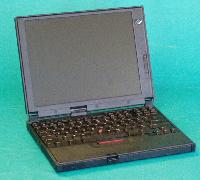 IBM Thinkpad 560 (Pentium 133). This was one of the thinest and lightest notebook
machines available at the time. It had no on-board removable storage, floppy and CD
were external boxes. Donated by Centerpoint Technologies.
IBM Thinkpad 560 (Pentium 133). This was one of the thinest and lightest notebook
machines available at the time. It had no on-board removable storage, floppy and CD
were external boxes. Donated by Centerpoint Technologies.
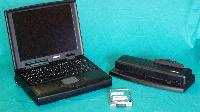 This EuroCom 6200 was my main portable machine for quite some time. It is a P233MMX with
64M. Like most of the EuroCom "Desktop Replacement" machines, it has internal floppy and
CD drives. To the right is the portable docking station. One nice feature of this machine
was that it used easily swappable hard drive "carriers", allowing me to effectively take
several complete different computers with me. One of these carriers is shown in front of
the computer.
This EuroCom 6200 was my main portable machine for quite some time. It is a P233MMX with
64M. Like most of the EuroCom "Desktop Replacement" machines, it has internal floppy and
CD drives. To the right is the portable docking station. One nice feature of this machine
was that it used easily swappable hard drive "carriers", allowing me to effectively take
several complete different computers with me. One of these carriers is shown in front of
the computer.
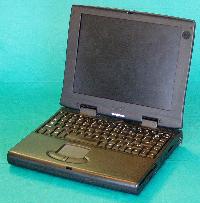 This is a EuroCom 1100, a K6/300 machine. It was given to me with a bad screen (apparently
left in a car, the heat had unbonded the LCD). At the time, its value had it been working
would have been about $200. EuroCom quoted me $800 for a replacement LCD, so it sat unfixed
for several years. One day I happened across an identical machine at a flea market which
had its main body/board broken (looks like someone stepped on it). Screen was in good
shape, so I fixed my 1100 for $5. Donated by G. Morrison.
This is a EuroCom 1100, a K6/300 machine. It was given to me with a bad screen (apparently
left in a car, the heat had unbonded the LCD). At the time, its value had it been working
would have been about $200. EuroCom quoted me $800 for a replacement LCD, so it sat unfixed
for several years. One day I happened across an identical machine at a flea market which
had its main body/board broken (looks like someone stepped on it). Screen was in good
shape, so I fixed my 1100 for $5. Donated by G. Morrison.
Other types
 The Citadel 80386SX/25 Infostation is a touch screen (Plasma) PC that is designed
to serve as a public information display terminal. It normally runs without a
keyboard, using only the touch screen for user input. It is mostly a "normal" PC
inside, and contains a solid state "flash" drive
instead of a hard drive. The back of the unit contains
connectors for a keyboard and external floppy drive, both of which are used during
software installation.
The Citadel 80386SX/25 Infostation is a touch screen (Plasma) PC that is designed
to serve as a public information display terminal. It normally runs without a
keyboard, using only the touch screen for user input. It is mostly a "normal" PC
inside, and contains a solid state "flash" drive
instead of a hard drive. The back of the unit contains
connectors for a keyboard and external floppy drive, both of which are used during
software installation.
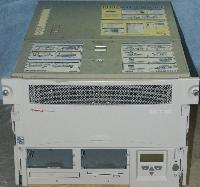 Ok - this one is definately not a "vintage" computer... but it was simply too
cool to turn down. The Compaq Proliant 8500 was the "ultimate" server in 1998
(and still pretty good today) - This one contains 4 Intel XEON processors (can
hold up to 8), a gigabyte of RAM (can go to 16gb), 11 hot-swappable PCI slots,
dual redundant and hot-swappable power supplies, hot-swappable fans, RAID
controller and many more high-reliability features. Designed for mounting in a
19 inch rack, at 140 lbs it's a bit heavy to lift to the desktop, so it is
pictured here on my workshop floor (It has fold-out carry handles for two
people). Donated by Kirk Russle (in exchange for a bit of lifting - VAXs are
even heaver than this thing).
Ok - this one is definately not a "vintage" computer... but it was simply too
cool to turn down. The Compaq Proliant 8500 was the "ultimate" server in 1998
(and still pretty good today) - This one contains 4 Intel XEON processors (can
hold up to 8), a gigabyte of RAM (can go to 16gb), 11 hot-swappable PCI slots,
dual redundant and hot-swappable power supplies, hot-swappable fans, RAID
controller and many more high-reliability features. Designed for mounting in a
19 inch rack, at 140 lbs it's a bit heavy to lift to the desktop, so it is
pictured here on my workshop floor (It has fold-out carry handles for two
people). Donated by Kirk Russle (in exchange for a bit of lifting - VAXs are
even heaver than this thing).
The IBM PC: First Impressions - Byte Oct81 (870k PDF)
Closer look at IBM PC - Byte Jan82 (3.6M PDF)
Jan82 Byte Magazine Cover featuring IBM PC (80k JPG)
Back to Old Computers
Copyright 2004-2007 Dave Dunfield.
 Where it all started. This is the original first edition 5150 PC, with
64K/256K mainboard. This is the only mainline IBM PC computer with a cassette
interface (The PCjr also has a tape interface), which can be seen in a
view from the back . Here is the
original documentation.
5150 PC Donated by Bob Maxwell.
Where it all started. This is the original first edition 5150 PC, with
64K/256K mainboard. This is the only mainline IBM PC computer with a cassette
interface (The PCjr also has a tape interface), which can be seen in a
view from the back . Here is the
original documentation.
5150 PC Donated by Bob Maxwell.




































